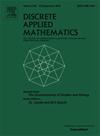连通图中解离集的数目
IF 1
3区 数学
Q3 MATHEMATICS, APPLIED
引用次数: 0
摘要
随着图论的发展,与图子结构枚举相关的极值问题,如独立集、匹配和诱导匹配等,已经成为一个突出的研究领域。图中顶点的子集,如果它诱导出顶点度不超过1的子图,则称为解离集,使其成为这些先前研究过的子结构的自然推广。在本文中,我们提出了严格增加连通图中解离集数目的有效工具。进一步证明了所有n阶连通图的最大解离集数分别为:2n−1+(n+3)·2n−52,ifnisodd;2n−1+(n+6)·2n−62,ifniseven。此外,我们确定了n阶树中解离集数量的可实现上界,并将相应的极值图表征为中间结果。最后,我们确定了在所有连接图中具有第二大解离集的候选单环图。本文章由计算机程序翻译,如有差异,请以英文原文为准。
The number of dissociation sets in connected graphs
Extremal problems related to the enumeration of graph substructures, such as independent sets, matchings, and induced matchings, have become a prominent area of research with the advancement of graph theory. A subset of vertices in a graph is called a dissociation set if it induces a subgraph with vertex degree at most 1, making it a natural generalization of these previously studied substructures. In this paper, we present efficient tools to strictly increase the number of dissociation sets in a connected graph. Furthermore, we establish that the maximum number of dissociation sets among all connected graphs of order is given by Additionally, we determine the achievable upper bound on the number of dissociation sets in a tree of order and characterize the corresponding extremal graphs as an intermediate result. Finally, we identify the unicyclic graph that is the candidate for having the second largest number of dissociation sets among all connected graphs.
求助全文
通过发布文献求助,成功后即可免费获取论文全文。
去求助
来源期刊

Discrete Applied Mathematics
数学-应用数学
CiteScore
2.30
自引率
9.10%
发文量
422
审稿时长
4.5 months
期刊介绍:
The aim of Discrete Applied Mathematics is to bring together research papers in different areas of algorithmic and applicable discrete mathematics as well as applications of combinatorial mathematics to informatics and various areas of science and technology. Contributions presented to the journal can be research papers, short notes, surveys, and possibly research problems. The "Communications" section will be devoted to the fastest possible publication of recent research results that are checked and recommended for publication by a member of the Editorial Board. The journal will also publish a limited number of book announcements as well as proceedings of conferences. These proceedings will be fully refereed and adhere to the normal standards of the journal.
Potential authors are advised to view the journal and the open calls-for-papers of special issues before submitting their manuscripts. Only high-quality, original work that is within the scope of the journal or the targeted special issue will be considered.
 求助内容:
求助内容: 应助结果提醒方式:
应助结果提醒方式:


